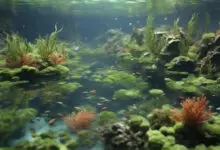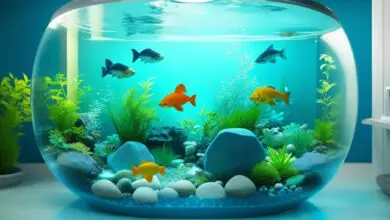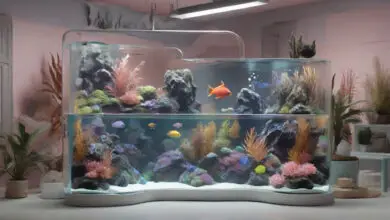Keeping Your Aquarium Sparkling Clean by Managing Water Temperature

An aquarium with clear water that allows viewing of vibrant, healthy fish swimming through aquatic plants is a wonderful thing. However, keeping the tank looking pristine takes work and getting the conditions right. One important factor that affects fish waste build up and algae growth is water temperature. By understanding how temperature impacts the nitrogen cycle, bacteria, and other aspects of your enclosed ecosystem, you can make adjustments to support cleanliness. This article explores managing temperature for reduced tank maintenance.
How Temperature Affects Fish Waste Process
Fish and other aquatic pets produce waste constantly through gills and solid excrement. This waste gives off compounds like ammonia and nutrients that can accumulate. The rate of waste production and decay speeds up in warm water compared to colder environments. Therefore, tanks kept at higher stable temperatures tend to need more frequent cleaning to preventIss cloudy water.
Additionally, higher heat accelerates the reproduction and growth of bacteria responsible for breaking down waste products. Beneficial bacteria in filters multiply faster when warmer, processing toxins more efficiently. However, pathogenic bacteria also thrive under tropical conditions. So tanks maintained around 80°F or more require close monitoring to not overload the biofilter while avoiding bacterial infections.
Impact on Algae Growth
Elevated water temperature combined with long daytime light exposure encourages the prolific growth of several types of nuisance algae in aquariums. Heat speeds up the photosynthesis process that allows green algae to quickly spread across glass walls and decor. Blue-green algae varieties similarly bloom under high heat and nutrient levels, secreting oils that create surface scum.
You’ll find yourself scrubbing the tank much more frequently if the water stays warmer. Quickly growing strands of hair algae will also need trimmed back oftener in hotter water before it overtakes plants. Limiting light duration can help slow algae down regardless of temperature. However, cooler water does impede its rampant spread somewhat naturally.
Ideal Temperature Range
The appropriate temperature range depends primarily on the type of aquatic life kept. Tropical freshwater fish species that originate from warm equatorial waters prefer sustained tank temperatures of 76-82°F generally. More temperate natives like goldfish and koi do better with cooler 64-72°F water. Know the natural climate your pets are adapted to and aim for the same.
Water that is too hot stresses fish reducing their health and lifespan over time. Chillier than ideal sustained temperatures can suppress immune systems and growth. Use submersible heaters and external cooling devices like air conditioning, fans, and chillers to maintain water within the ideal steady range.
Adjusting Temperature to Assist Cleaning
While each aquarium has an optimal temperature range, make use of warmer or cooler conditions at times to facilitate maintenance. Here are some tips:
- Boost heat to 82-86°F for 1-2 days to accelerate waste breakdown assisting gravel cleaning. Then bring back to normal stable zone.
- Raise temperature to speed up life cycles of parasites like ich then treat to kill them quicker with less reinfection.
- Drop to 72°F during tank reboots to slow algae growth for easier removal and limiting rebound while adding livestock back.
- Cut temperature down significantly when treating most bacterial infections to hamper spread and antibiotic resistance evolution.
The above are just examples of strategically altering ambient tank temperature for short periods to reduce certain cleaning headaches or improve remedies. Don’t keep water outside species-specific ranges for too long though. Finding the right heat balance assists keeping your aquarium water pristine and pets healthy!
Impact on Beneficial Bacteria
The beneficial bacteria that populate filter media play a crucial role in breaking down fish waste to keep water clean and non-toxic. These bacteria thrive best within certain temperature ranges depending on the species. Some prefer warmer tropical temperatures while others work better at more temperate levels.
For freshwater tropical tanks, nurturing bacteria that process ammonia and nitrite function most efficiently between approximately 75-86°F. Temperatures cooler than 68°F start slowing their waste conversion metabolism more and more. At less than 50°F, the cycles nearly halt.
Therefore, an unexpected crash in tank temperature could essentially knock out cycling bacteria. With cooler water, less waste also solubilizes from gravel and decor slowing the whole process. Strategies like wrapping filters or adding supplemental heat may help whenever dealing with a major cool down.
Temperature Fluctuations
While fish and bacteria can adapt to a wide range of sustained temperatures, fluctuating up and down by several degrees through the day is highly stressful. Changes beyond 2-3° warmer at day and cooler at night can cause health issues over time.
Sudden dramatic temperature shifts of 10+ degrees from equipment failure or incorrect use can even shock and kill sensitive aquatic life. Ensure you have backups and safeguards to prevent extreme hot or cold swings. Invest in battery-powered air pumps, chillers, and heating systems for emergency use whenever necessary.
Using Temperature for Disease Management
Altering water temperature outside of normal ranges for short time periods can also positively or negatively influence aquatic diseases:
- Ich reproduces fastest at temperatures around 72-75°F. Raise to 86°F+ to speed up lifecycle for quicker treatment.
- Columnaris bacterial infections thrive in warmer water of 85°F+, making it more aggressive. Cool to under 75 to inhibit spreading.
- Chilling a quarantine tank to under 60°F slows spread of most pathogens allowing fish to recover when combined with appropriate treatments.
Change temperature carefully by no more than a few degrees daily when using as part of a disease management regimen. Extensive shifts too rapidly add more stress to already sick fish. Use this strategy as one part of an integrated medication plan, not primarily alone.
Heater Selection Considerations
Choosing the appropriate aquarium heater wattage and design is imperative to maintaining a stable temperature. Undersized heaters struggle to keep larger tanks warm. Meanwhile, one too powerful can literally cook fish if it remains stuck on.
Select quality heaters with advanced features like:
- Digital thermostats – Maintains set temperature precisely without fluctuation
- Fail-safe mechanisms – Shut heater off if overheating detected as backup protection
- Dual temperature sensors – Compare readings confirming accuracy
Invest in a backup secondary heater as well sized at roughly half wattage. This provides redundancy if issues ever develop with the primary so temperature remains consistent avoiding crashes.
Monitoring Water Temperature
With temperature being such a crucial water parameter, invest in quality thermometers to monitor the tank and equipment. Standard floating glass thermometers only provide limited accuracy. Digital probe thermometers give a precise live reading.
Also stick-on LCD strip thermometers at various tank heights lets you see gradients. Compare readings from multiple devices for several minutes to confirm consistency. Calibrate periodically by testing in ice water ensuring precision.
With close temperature monitoring, you can observe trends and seasonal impacts allowing adjustment of tank heating/cooling needs based on real evidence. This allows optimizing the balance for animal health and easier maintenance.
Temperature Control Systems
Maintaining a stable appropriate temperature often requires using the following heating/cooling methods:
Heating
- Submersible heaters (most common)
- In-line heaters
- Undergravel heat wire systems
- Flexible heating pads attached under tank
Cooling
- Aquarium chillers (refrigeration units)
- Air conditioners and evaporative (swamp) coolers directing airflow
- Video computer cooling fans blowing across water surface
- Auto top-off systems replacing evaporated water
Combine multiple units and backup devices like battery-powered air pumps and mini heaters to create redundancy. This ensures stable temperatures are maintained reliably long-term even during power failures.
Temperature Impacts on Fish Behavior
Warmer or cooler water impacts fish energy levels and activity similar to ambient air temperatures in nature changing animal behavior. Understand these shifts to aid care:
Increased Temps
- More aggressive territorial fights
- Increased spawning activity
- Faster darting around raising stress
- Reduced oxygen saturation requiring more aeration
Decreased Temps
- Slower sluggish movements and loss of color
- Increased disease susceptibility
- Congregating seeking warmth
- Better gas exchange with higher oxygen
Observe your fish closely when intentionally or unintentionally shifting temperatures. Adjust air pumps, foods, tankmates, etc. to reduce negative impacts on health and safety based on their observed behavioral changes.
Conclusion
The expansive topic of managing water temperature could fill an entire book explaining usage for each aquatic species. However, the central key is maintaining stability within an ideal range. Frequent hot or cold spikes harm inhabitants damaging health and requiring more tank intervention to sustain balance. Educate yourself on your pets’ needs and invest in quality heating/cooling devices with backups and monitoring to stay consistent. Strategically shift temperatures on occasion as an integrated tank cleaning or treatment approach avoiding extremes. With proper stable warmth, both fish and aquarist thrive together!







